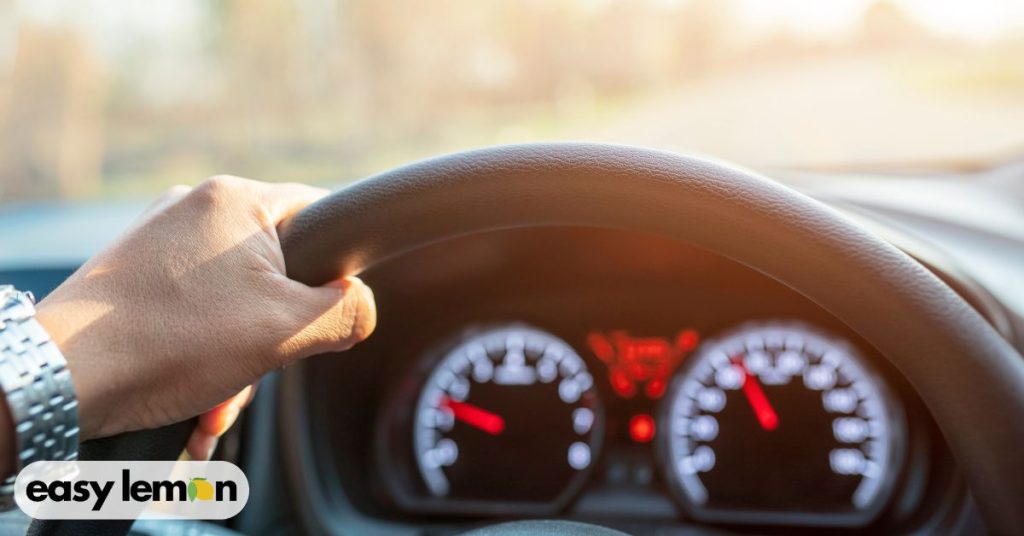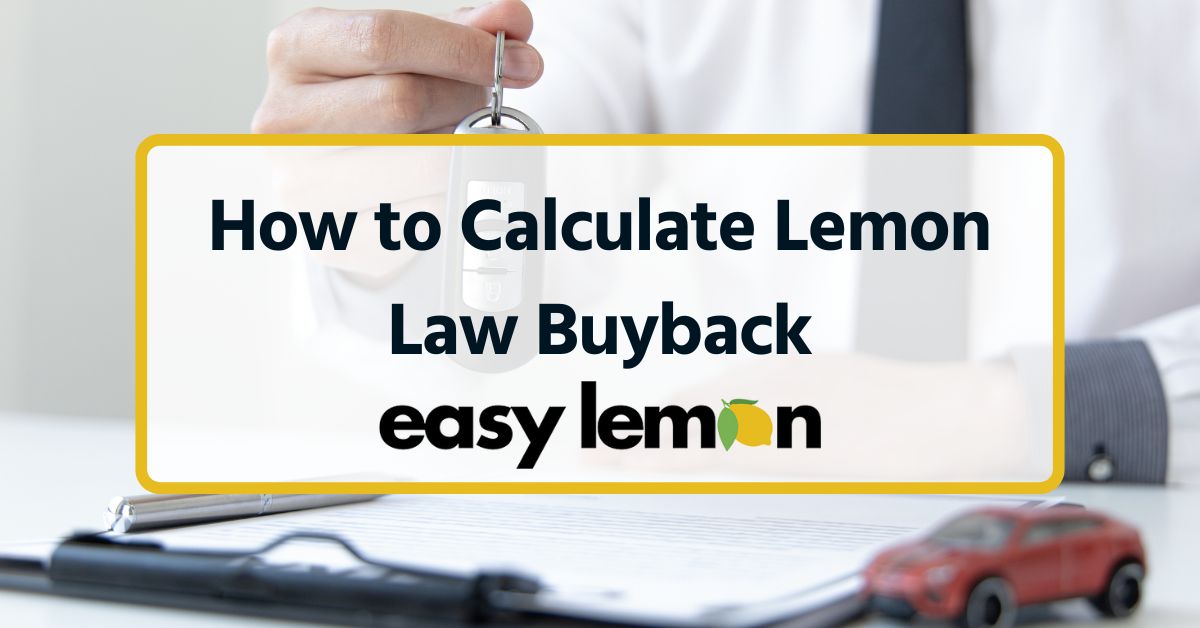Lemon Law buyback is a situation when a manufacturer repurchases a defective vehicle from the original buyer or lessee due to a substantial defect that has not been fixed after a reasonable number of repair attempts. Knowing how to calculate the Lemon law buyback is essential because it ensures that you, the customer, will obtain compensation for the faulty vehicle.
The Lemon Law Buyback involves various aspects: deducting a mileage offset, incidental damages, and an allowance for use in the original purchase price or the manufacturer’s suggested retail price. Likewise, for leased vehicles, this must include the lease payments and rental car cost. That’s why a buyback calculator will help you receive the sum of the cash compensation.
At Easy Lemon, we will help you calculate the buyback from your lemon car using the most advanced techniques involving all the variables, such as incidental and consequential expenses, in order to obtain your final Lemon law buyback amount. As part of our services, we will help you in your legal journey to present a Lemon law claim and beyond. We offer free consultation; contact us now and tell us your story.
In this blog post, we will cover everything related to the Lemon Law buyback calculator and the possible variables influencing the final amount, such as service contracts, remaining loan balances, incidental and consequential estimated usage fees, diminished value, and the estimated refund.
What Is a Lemon Law Buyback?

The buyback process starts when the manufacturer agrees to refund the buyer the money spent on the vehicle that turned out to be a lemon. Moreover, this process is not something that happens in every Lemon law case, but when it does, the state laws obligate the manufacturer to reimburse the incidental cost you encountered for vehicle defects. This may include rental car fees, personal property damage, attorney fees, your down payment, mileage deduction and everything related to the Lemon law refund.
The Lemon law cases include almost every financial type of charge the buyer made during the reparation attempts, and the legal fees in most cases. However, the above factors also have some variables that can reduce the final refund. It’s common that take into consideration the mileage offset, remaining lease obligations, collateral charges, and the incidental and consequential damages. It’s essential to understand that a Lemon Law buyback formula includes these factors to offer a final amount for the customer.
Understanding the difference between a replacement vehicle and a buyback is very important because, for the first one, the manufacturer will exchange the defective vehicle for one similar to or with the same specs without refunding the buyer for the faulty car. The Lemon Law buyback requires the manufacturer to repurchase the vehicle and return all the costs paid to the buyer. Of course, it also includes other costs and deductions, depending on the case.
To qualify for a Lemon Law Buyback is not simple since this type of settlement, in comparison to the other ones such as the cash and keep and the GM settlement, is not among the most common ones. The buyer is required to take certain steps before getting to the vehicle buyback. Generally, you will need to go through repair attempts, gather documents, formally notify the manufacturer or the dealership, consider legal assistance, negotiate or initiate an arbitration process, file the claim, and even possibly go to court to obtain a Lemon Law buyback resolution.
4 Factors That Affect Lemon Law Buyback Calculation

The factors influencing the Lemon Law buyback calculation differ from case to case; however, they can be summarized in four main factors, including most of the situations and variables in the process. These factors can affect the final amount of your Lemon law refund and let you obtain a better or worse settlement with the buyback.
Vehicle Purchase Price: What Will Be My Cash Compensation
The original purchase price of the vehicle is the base for the buyback calculation. This means your down payment, license fees, loan balance, and service contracts are all included in this situation; however, that is not all, since they also use other costs to be included during the purchase or lease of the vehicle as part of the same service contract.
The factors influencing the Lemon Law buyback calculation differ from case to case; however, they can be summarized in four main factors, including most of the situations and variables in the process. These factors can affect the final amount of your Lemon law refund and let you obtain a better or worse settlement with the buyback.
Vehicle Purchase Price: What Will Be My Cash Compensation
The original purchase price of the vehicle is the base for the buyback calculation. This means your down payment, license fees, loan balance, and service contracts are all included in this situation; however, that is not all, since they also use other costs to be included during the purchase or lease of the vehicle as part of the same service contract.
Additional Costs: Incidental and Consequential Expenses
- Sales taxes, registration fees, down payments, outstanding loans, and dealer fees are often included in the initial vehicle payment.
- Any optional add-ons or extended warranties may also be part of the price reflected and considered in the buyback calculation.
The relevance of knowing the initial price paid is that it represents a starting point for the buyback calculation before any depreciation or deductions that can be applied for the usage and other variables used to obtain the actual price of your vehicle.
Mileage and Depreciation

One of the most important factors influencing the depreciation is the number of miles driven, which will be expressed as the vehicle’s depreciation. Depending on the condition of your car, this can impact the final buyback calculation and reduce the final amount you will receive.
Depreciation Calculation:
- Calculating the depreciation of the defective vehicle is typically based on the car’s mileage at the time of the buyback request.
- It’s important to understand that some states or manufacturers use a specific formula to provide an estimated refund value, including how much is lost per mile.
Impact of Low vs. High Mileage:
According to the mileage, the vehicle can expect a mileage deduction based on the amount driven. In most cases, if your defective vehicle has a low mileage, you may receive a higher buyback due to less wear and tear. On the other hand, if you have a high-mileage vehicle, you may have more significant depreciation, thus lowering the buyback amount.
The most common mileage offset formula manufacturers use is the mileage at the first repair attempt divided by 120,000 multiplied by the vehicle’s purchase price. This will show a good picture of when the car starts to fail. For example, if your car has 5,000 miles when it has the first repair attempt, and the total price of the car was $30,000, the formula should look like 5,000 / 120,000 × 30,000; the result for the mileage offset will be 1,250 for the final deduction for usage fee.
Repair and Maintenance Costs
Repair costs can influence the final amount, whether covered by the warranty or out-of-pocket expenses. However, they still represent a factor to consider for the buyback calculation:
Warranty Repairs: Every repair done under warranty or service agreements must be refunded in part or deducted from the final buyback offer.
Non-Warranty Repairs: Out-of-pocket expenses for repairs can also be considered in the calculation; some states may not be included or, according to the manufacturer’s policy, may not cover these non-warranty repairs.
Repair Frequency: A relevant factor is the frequency of repairs for the same issue or multiple defects; this can increase the manufacturer’s buyback offer.
Type and Severity of Defects
The type and severity of the defect represent an important part of the buyback evaluation and final offer. If the defect is serious, it will affect the car’s functionality or safety for the driver and passenger. Some defects are faulty engines, transmission, chassis, brakes, or electrical issues that lead to a higher risk. If the defect is severe, it may have a higher chance of obtaining a higher buyback value.
If a faulty vehicle has multiple defects, its value can turn out to be lower. When the buyback offer occurs, the manufacturer should adjust the final amount accordingly to the defects. Even if the vehicle has more defects compromising its value and usage, the manufacturer should accept their responsibility because your Lemon law case will be stronger. You could then be offered a higher buyback amount.
What Is a Lemon Law Buyback Calculator?

A Lemon Law buyback calculator is a tool that allows you to estimate how much you can receive for having a lemon vehicle, which requires going through the legal process. This calculator can help you quickly determine the potential buyback amount without legal assistance. However, this is not a set-in-stone amount since the final offer may vary according to the above factors. We still recommend seeking legal help from an experienced Lemon Law attorney to obtain a more precise result. Experienced attorneys at Easy Lemon can guide you through the process and help you get an accurate estimate for your claim.
How It Works: A Lemon Law Refund Buyback Calculator
Calculators will require you to fill in some information about your car to retrieve a value that must include the same expenses and depreciations that may affect the lemon vehicle. In general, you will need to follow these simple steps:
Input Information: Vehicle purchase price, mileage, repair history, and defects.
Calculation Process: The tool will also help you calculate factors related to depreciation, repairs, and defect severity to estimate the buyback amount.
Benefits of Using a Buyback Calculator
When you use a buyback calculator, you will obtain some benefits since it’s a tool that can help you better understand your case and estimate the possible amount you may receive. Some advantages of using a buyback calculator are:
- Quick Estimates: You will know the refund you could receive before contacting a lawyer.
- Limitations of the Calculator: Calculators are a great tool, but they can’t predict and follow up on all the variables related to the vehicle. Still, they give a great estimate to proceed with the process.
- General Estimates: It’s essential to know that the calculator will only provide estimates, never the exact figures that the manufacturer will offer.
- State-Specific Rules: Some states have varying rules that influence the final buyback amount, but the calculator can still provide a big picture for your case.
When to Use a Lemon Law Buyback Calculator For A Defective Vehicle?
There are different scenarios where you can use a buyback calculator, which can help you during your legal journey. As a powerful tool, it will push you to take the next step to obtain a fair settlement for the purchase or lease of a faulty vehicle.
Before Filing a Lemon Law Claim: The calculator is a great tool for estimating your entitlement to Lemon law damages before pursuing a formal claim for the lemon vehicle.
After Multiple Repair Attempts: If your car has gone through numerous repair attempts for the same issue, use the calculator to determine if your situation qualifies for a buyback.
If You’re Unsure About Your Eligibility: If you don’t know if your vehicle qualifies for the Lemon Law, the calculator will help you quickly assess whether your vehicle meets the requirements without consulting a lawyer immediately.
To Compare Potential Outcomes: Before deciding whether to accept a buyback offer or pursue a lawsuit, we recommend using the calculator to compare with an estimated refund for better compensation.
When Considering Settlement vs. Buyback: Although settlement can include a buyback, there are cases where you may be unsure if you must request a buyback. Using the calculator will give you a ballpark figure to help you decide whether to settle or move forward with the request.
How to Get the Full Value of Your Lemon Law Buyback

Lemon Law has some limitations depending on the state. Moreover, if you want to obtain the maximum value for your buyback process, you will need to follow some steps that can help you in your journey, such as:
File early: The sooner you file a claim, the better your chances of a favorable outcome and higher offers.
Maintain detailed repair records: For all Lemon law processes, you must have detailed documentation, such as receipts and repair history, showing the car’s defects with a date and time included if possible.
Don’t accept the first offer: The first offer is always the lowest. Manufacturers may offer a low buyback at first to try to avoid extra cost, so don’t settle without negotiating.
Hiring a Lemon law attorney: A Lemon Law expert, such as an attorney, can help you during your legal journey. If you are not sure to contact a Lemon law lawyer; the benefits offered will ensure you obtain a fair buyback and a settlement that may include the attorney’s fees.
Need Help Maximizing Your Lemon Law Buyback Refund?
To maximize your Lemon Law Buyback Refund, it’s essential to understand how to move forward and when to ask for help. Each case is different; not all cases will have a buyback refund. However, if you want to maximize the refund, we recommend understanding if your vehicle qualifies as a lemon. Once you have the confirmation, knowing the possibility of obtaining a buyback settlement will help you take the next step. If you want to present a formal claim, we recommend contacting a specialized attorney and using other tools such as a buyback calculator. If you are ready to move your case forward or obtain an estimated amount, a Lemon law attorney can be helpful to you and will calculate the final settlement.
Easy Lemon can help you obtain a fair buyback offer and the compensation you deserve for all the issues with a faulty car. We understand each case is unique and will require Lemon Law experts to handle the negotiations and represent you in court if needed. We offer a free case evaluation; contact us today, and we will gladly assist you in your legal journey.


